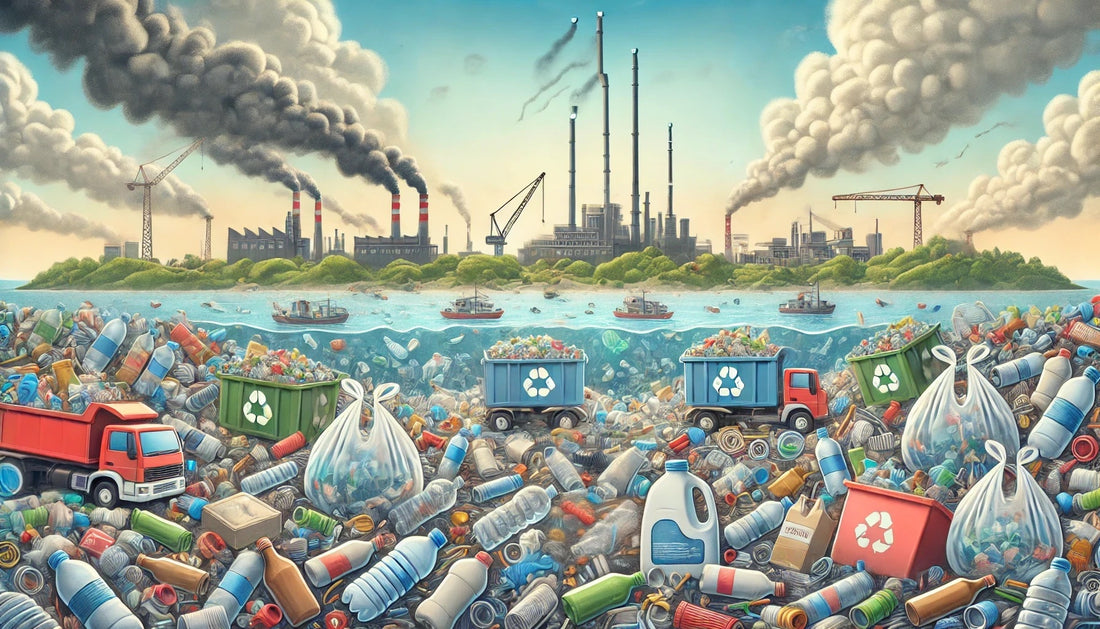Every year, 350 million tons of plastic waste is dumped into landfills or oceans; but only 9% of the world’s plastic is actually recycled.
And it’s getting worse, with plastic pollution projected to double by 2030 (1). This alarming trend raises critical questions about the efficiency of our recycling systems and the broader environmental implications.
Here are the reasons behind this dismal recycling rate and what can be done to improve it.
1. The Complexity of Plastic Types
One of the primary reasons for the low recycling rate of plastic is the sheer variety of plastic types. Plastics are categorized into different types, each with distinct chemical properties. Common types include PET (polyethylene terephthalate), HDPE (high-density polyethylene), PVC (polyvinyl chloride), LDPE (low-density polyethylene), PP (polypropylene), and PS (polystyrene). Each type of plastic requires a different recycling process, and not all recycling facilities are equipped to handle every type. This complexity often leads to many plastics being deemed non-recyclable by local recycling programs and ending up in landfill.
2. Contamination Issues
For plastic to be recycled, it needs to be clean and free from contaminants. Contamination occurs when non-recyclable materials, food residues, or other waste mix with recyclable plastics. Contaminated plastics are more challenging to process and can even spoil entire batches of recyclables. As a result, contaminated plastics often end up in landfills rather than being recycled.
3. Economic Factors
Recycling plastic is not always economically viable. The process of collecting, sorting, cleaning, and processing plastics can be expensive. When the cost of producing new plastic is lower than recycling existing plastic, manufacturers are less incentivized to use recycled materials. Market demand for recycled plastic can fluctuate, impacting the profitability of recycling programs. Without sufficient economic incentives, the amount of plastic that gets recycled is limited.
4. Insufficient Infrastructure
Many regions lack the necessary infrastructure to support comprehensive plastic recycling programs. This includes everything from collection and sorting facilities to advanced recycling plants capable of handling various plastic types. Inadequate infrastructure means that even if people are willing to recycle, the local systems may not be able to process their recyclables efficiently.
5. Lack of Awareness and Participation
Public awareness and participation are crucial for effective recycling. Many people are either unaware of proper recycling practices or simply do not participate in recycling programs. Misinformation about what can and cannot be recycled leads to increased contamination and inefficiencies. Educating the public about the importance of recycling and how to do it correctly - such as rinsing off food residue - is essential for improving recycling rates.
The Way Forward
Addressing the challenges of plastic recycling requires a multi-faceted approach:
1. Improving Recycling Technologies
Investing in advanced recycling technologies can enhance the efficiency and effectiveness of plastic recycling. Innovations such as chemical recycling can break down plastics into their basic chemical components, making it possible to recycle more types of plastics.
2. Expanding Infrastructure
Building more recycling facilities and upgrading existing ones can increase the capacity to handle diverse plastic types and larger volumes of recyclables.
3. Economic Incentives
Implementing policies that encourage the use of recycled materials, such as subsidies for manufacturing with recycled materials, while placing taxes on virgin plastic production, could make recycling more economically viable.
4. Education and Awareness
Public education campaigns can raise awareness about the importance of recycling and provide clear guidelines on how to recycle properly. Encouraging community participation can significantly boost recycling rates.
5. Reducing Plastic Production
Ultimately, reducing the production and consumption of single-use plastics is crucial. Emphasizing the use of sustainable alternatives and promoting a circular economy where materials are reused and recycled can help address the root causes of plastic waste.
If you'd like to avoid using plastic, check out our plastic-free Laundry Sheets and Dishwasher Sheets. Buy 3 and get 1 free during Plastic Free July.
Citations:


1 comment
Informative. Keep up the research into reducing plastic pollution!